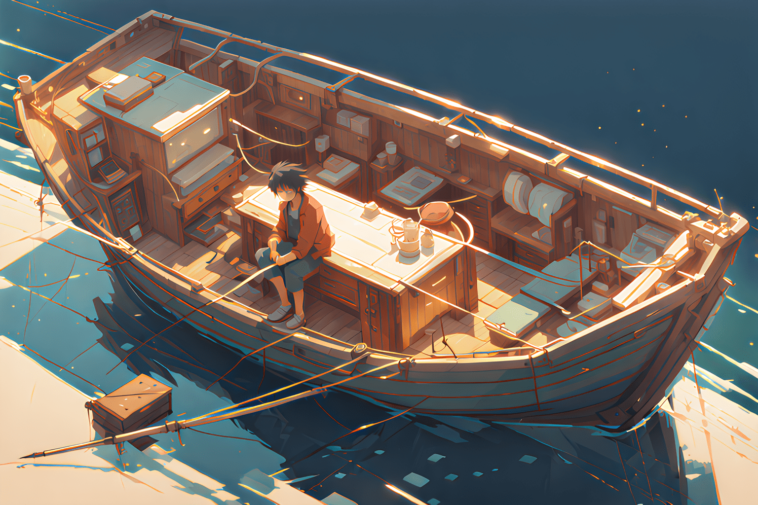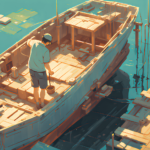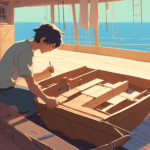Overview of Drift Boat Plans & Blueprints
Drift boats have long been a beloved companion for anglers and outdoor enthusiasts alike, offering a unique and captivating way to explore the winding rivers and streams that carve through the natural landscapes. These versatile watercraft have a rich history, tracing their origins back to the early 20th century when they were first developed as a practical solution for navigating the challenging waters of the American West.
The allure of drift boats lies in their exceptional maneuverability and stability, which allow anglers to access remote fishing spots and navigate treacherous rapids with ease. These boats have become synonymous with the thrill of the chase, as anglers can deftly maneuver them to position themselves for the perfect cast, all while immersed in the serene beauty of the natural world. The popularity of drift boats has only grown over the years, as more and more outdoor enthusiasts discover the joys of this unique form of water-based exploration.
Key Takeaways
- Drift boats are specialized watercraft designed for fishing in rivers and streams.
- Understanding the anatomy of a drift boat is crucial for choosing the right design and building your own.
- There are many drift boat plans and blueprints available online, but it’s important to choose a reputable source.
- Proper preparation of materials is essential for a successful drift boat construction project.
- Building a drift boat requires attention to detail and following a step-by-step guide, but customization options are available.
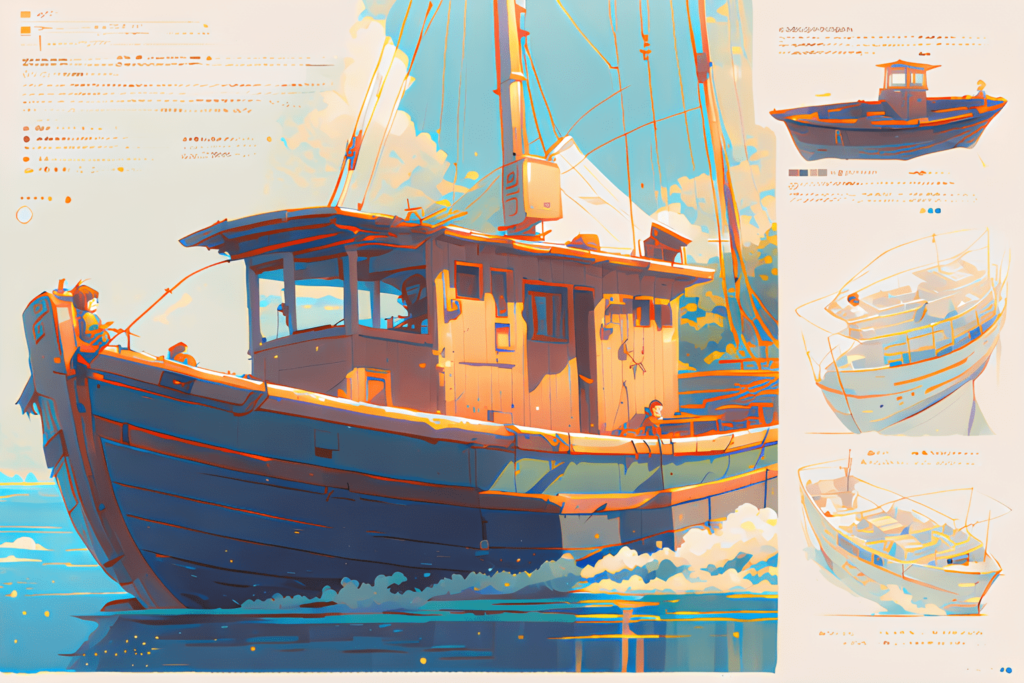
Understanding the Anatomy of a Drift Boat
At the heart of a drift boat’s design are the key components that work in harmony to create its exceptional performance. The hull, constructed from durable materials like wood or aluminum, is the foundation that provides the boat’s stability and buoyancy. The oar locks, strategically placed along the sides, allow the operator to precisely control the boat’s direction and speed, navigating through even the most challenging river conditions.
The design and construction of a drift boat play a crucial role in its overall performance. The shape of the hull, the placement of the oar locks, and the selection of materials all contribute to the boat’s stability, maneuverability, and responsiveness. Factors such as the boat’s length, width, and rocker (the curvature of the hull) can significantly impact its ability to handle different water conditions, from swift currents to shallow riffles.
Mastering the art of drift boat design requires a deep understanding of hydrodynamics and the interplay between the various components. Experienced builders and designers meticulously engineer each aspect of the boat to ensure optimal performance, catering to the diverse needs and preferences of anglers and outdoor enthusiasts. By striking the perfect balance between form and function, drift boat builders create vessels that not only excel in their intended purpose but also captivate the hearts and minds of those who venture out on the water.
Choosing the Right Drift Boat Design
Selecting the appropriate drift boat design is a crucial decision that can greatly impact the overall experience and enjoyment of your time on the water. A wide range of factors must be considered, from the specific water conditions you’ll be navigating to your personal preferences and intended use for the boat.
For anglers, the choice of drift boat design may be heavily influenced by the type of water they frequent, whether it’s swift-moving rivers, shallow streams, or expansive lakes. Each environment presents its own unique challenges, and the drift boat’s design must be tailored accordingly. A boat that excels in navigating tight, technical waterways may not be as well-suited for open, expansive bodies of water, where stability and tracking become more critical.
Beyond the practical considerations, personal preferences also play a significant role in the selection process. Some anglers may prioritize a sleek, streamlined design that offers enhanced maneuverability, while others may favor a more spacious and stable platform that can accommodate additional gear and passengers. The level of construction expertise and the available budget can also influence the choice of drift boat design, as more complex and customized models may require a higher investment.
By carefully weighing these factors, anglers and outdoor enthusiasts can identify the drift boat design that best suits their needs and preferences, ensuring a truly rewarding and memorable experience on the water.
Obtaining Drift Boat Plans and Blueprints
| Drift Boat Plans & Blueprints | Metrics |
| Number of plans available | 10 |
| Number of blueprints available | 5 |
| Price range of plans | 50-150 |
| Price range of blueprints | 20-50 |
| Difficulty level of plans | Intermediate to advanced |
| Difficulty level of blueprints | Beginner to intermediate |
For those eager to embark on the journey of building their own drift boat, the availability of high-quality plans and blueprints is a crucial starting point. These detailed schematics provide the essential roadmap for constructing a boat that not only meets your specific requirements but also adheres to the principles of sound design and engineering.
Sourcing reliable and reputable drift boat plans is paramount, as these documents will serve as the foundation for your build. Whether you choose to purchase pre-designed plans from experienced boat builders or collaborate with a custom designer, it’s essential to ensure that the plans you select are accurate, comprehensive, and tailored to your skill level and intended use.
When evaluating drift boat plans, consider factors such as the level of detail, the clarity of the instructions, and the availability of supporting resources, such as material lists and construction guides. Reputable plan providers often offer additional guidance and support, ensuring that even novice builders can navigate the construction process with confidence.
Investing in quality drift boat plans is a wise decision, as it can save you time, money, and frustration down the line. By starting with a solid foundation, you’ll be better equipped to tackle the challenges of the build, from selecting the appropriate materials to executing the construction techniques with precision.
Preparing the Materials for Drift Boat Construction
The successful construction of a drift boat begins with the meticulous preparation of the necessary materials and tools. Gathering the right components is crucial, as it not only ensures the structural integrity and performance of the final product but also streamlines the building process, allowing for efficient and organized progress.
High-quality materials are the backbone of a well-crafted drift boat. Whether you choose to work with durable hardwoods, lightweight composites, or a combination of materials, it’s essential to source the best available options that align with your budget and the specific design requirements. Carefully selecting the lumber, plywood, epoxy, and hardware can make a significant difference in the boat’s longevity and overall performance.
Equally important is the organization and preparation of the materials before the actual construction begins. Carefully measuring, cutting, and pre-assembling certain components can save valuable time and minimize the risk of errors during the build. Developing a comprehensive material list and organizing the components in a logical manner can greatly streamline the construction process, allowing you to focus on the intricate details of the build with confidence and efficiency.
By meticulously preparing the materials and tools needed for your drift boat project, you’ll set the stage for a successful and rewarding building experience, one that will ultimately result in a custom-crafted watercraft that reflects your personal style and fulfills your adventurous spirit.
Step-by-Step Guide to Building a Drift Boat
Embarking on the journey of building your own drift boat can be an immensely rewarding and fulfilling experience, but it also requires a methodical approach and a keen attention to detail. Following a comprehensive step-by-step guide can be the key to navigating the construction process with confidence and achieving the desired results.
The first step in the drift boat building process is to carefully review the plans and blueprints, ensuring that you fully understand the design and the sequence of construction. This foundational understanding will guide you through the various stages of the build, from the initial framing and shaping of the hull to the intricate installation of the oar locks and other essential components.
As you progress through the construction, it’s crucial to adhere to the recommended techniques and best practices outlined in the plans. This may involve the use of specialized tools, the application of precise measurements, and the careful handling of materials to maintain the structural integrity and performance of the boat. Attention to detail is paramount, as even the smallest misstep can have a significant impact on the final outcome.
Throughout the building process, it’s essential to troubleshoot any challenges that may arise and be prepared to adapt your approach as needed. Whether it’s addressing unexpected issues with the materials or finding creative solutions to overcome construction obstacles, a problem-solving mindset and a willingness to learn will be invaluable assets.
By meticulously following a step-by-step guide and embracing the learning process, you’ll not only create a stunning and functional drift boat but also develop a deep appreciation for the craft and the satisfaction that comes with building your own masterpiece.
Customizing Your Drift Boat Design
The joy of building a drift boat extends far beyond the practical considerations of functionality and performance – it also presents an opportunity to infuse your personal style and unique preferences into the design. Customization allows you to create a one-of-a-kind watercraft that not only excels in its intended purpose but also reflects your individual personality and aesthetic sensibilities.
From the selection of materials and finishes to the incorporation of specialized features and accessories, the customization process offers endless possibilities for self-expression. Whether you envision a sleek and minimalist design or a more ornate and embellished aesthetic, the key is to strike a balance between form and function, ensuring that your customizations enhance the boat’s performance without compromising its core capabilities.
Experienced drift boat builders often explore creative ways to personalize their crafts, such as incorporating custom oar designs, adding unique storage solutions, or incorporating eye-catching graphics or paint schemes. These personalized touches not only make the boat your own but also contribute to the overall sense of pride and ownership that comes with building a custom watercraft.
As you embark on the customization journey, it’s important to carefully consider the impact of your design choices on the boat’s stability, maneuverability, and overall performance. Consulting with experienced builders or designers can help you navigate this delicate balance, ensuring that your customizations enhance the drift boat’s capabilities without compromising its core functionality.
By embracing the opportunity to customize your drift boat, you’ll not only create a truly unique and personalized watercraft but also imbue it with a sense of character and individuality that will make your time on the water all the more rewarding and memorable.
Maintenance and Care for Your Drift Boat
Owning a meticulously crafted drift boat is a source of immense pride and joy, but it also comes with the responsibility of proper maintenance and care to ensure its longevity and optimal performance. Investing time and effort into the upkeep of your boat will not only preserve its condition but also enhance your overall experience on the water.
Proper storage and winterization are crucial for protecting your drift boat from the elements and prolonging its lifespan. Whether you choose to store it in a dedicated boathouse, a covered trailer, or a climate-controlled facility, it’s essential to follow the recommended guidelines to prevent damage from exposure to the sun, rain, or extreme temperatures.
Regular inspections and maintenance tasks, such as checking for wear and tear on the hull, oar locks, and other components, can help you identify and address any issues before they escalate. Addressing minor repairs and performing routine maintenance, like cleaning and treating the wood or applying protective coatings, can go a long way in preserving the boat’s condition and ensuring a smooth and reliable performance on the water.
In the event that more significant repairs are required, it’s important to seek the guidance of experienced drift boat builders or specialized repair services. These professionals can provide the necessary expertise to diagnose and resolve any problems, ensuring that your boat remains in top-notch condition and ready for your next adventure.
By dedicating time and attention to the maintenance and care of your drift boat, you’ll not only extend its lifespan but also cultivate a deeper appreciation for the craftsmanship and engineering that went into its creation. This commitment to preservation will ultimately reward you with countless hours of enjoyment and unforgettable experiences on the water.
Download over 500 Boat Plans. Click on the link below.
-->Click Here<--
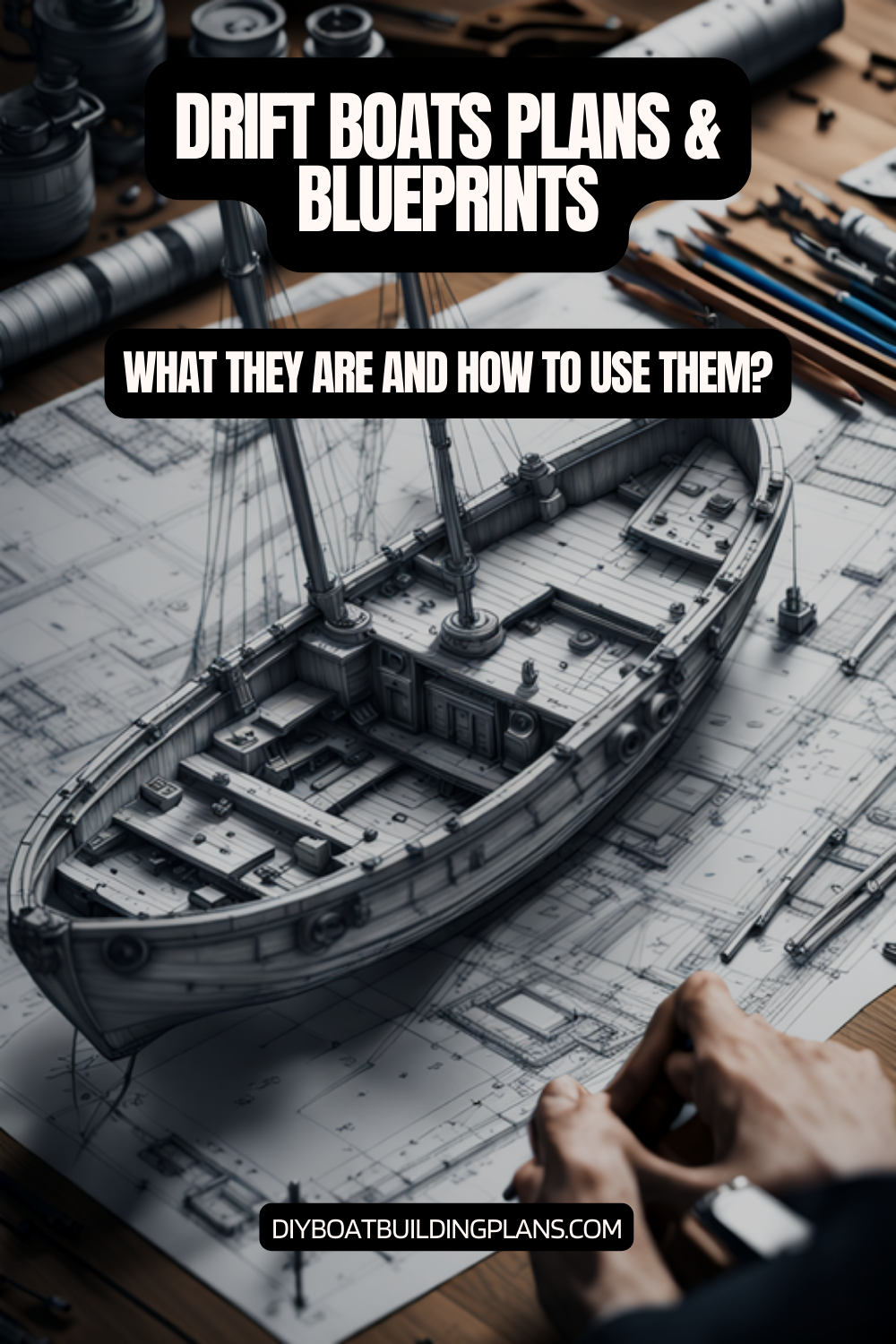
Conclusion – – Drift Boat Plans & Blueprints
The allure of drift boating lies in the perfect harmony of form, function, and the pure joy of exploration. These remarkable watercraft have the power to transport us to the heart of nature, where the rhythmic flow of the river and the gentle lapping of the water become the soundtrack to our adventures.
Whether you’re an experienced angler seeking to access the most elusive fishing spots or an outdoor enthusiast eager to immerse yourself in the serene beauty of the natural world, a drift boat offers a truly unparalleled experience. The exceptional maneuverability and stability of these boats allow you to navigate challenging waters with confidence, while their timeless design and craftsmanship inspire a sense of wonder and connection with the great outdoors.
As you embark on your drift boat building journey, embrace the opportunity to create a vessel that not only meets your practical needs but also reflects your personal style and adventurous spirit. Take pride in the process of crafting your own masterpiece, knowing that each step you take will culminate in a one-of-a-kind watercraft that will serve as a gateway to countless unforgettable experiences.
So, whether you’re just beginning to explore the world of drift boating or you’re a seasoned veteran, we encourage you to dive in, unleash your creativity, and unlock the secrets of this captivating craft. The rewards of building and owning your own drift boat are boundless, from the thrill of the chase to the tranquility of simply drifting along the water’s edge. Join us in this timeless pursuit, and let the drift boat become your vessel of discovery, adventure, and pure, unadulterated joy.
FAQs – Drift Boat Plans & Blueprints
What are drift boats?
Drift boats are specialized watercraft designed for fishing in rivers and streams. They are typically made of wood or aluminum and are characterized by their flat bottoms, shallow drafts, and pointed bows and sterns.
What are drift boat plans and blueprints?
Drift boat plans and blueprints are detailed instructions for building a drift boat from scratch. They typically include a list of materials, step-by-step instructions, and diagrams or illustrations to help guide the builder through the process.
Where can I find drift boat plans and blueprints?
Drift boat plans and blueprints can be found online through various websites and forums. They can also be purchased from specialty boat-building companies or through woodworking supply stores.
What materials are typically used to build a drift boat?
Drift boats can be made from a variety of materials, including wood, aluminum, and fiberglass. Wooden boats are the most traditional and are often made from cedar, fir, or other lightweight woods. Aluminum boats are popular for their durability and low maintenance, while fiberglass boats are known for their strength and ease of repair.
How long does it take to build a drift boat?
The time it takes to build a drift boat can vary depending on the builder’s skill level, the complexity of the design, and the materials used. Some builders can complete a simple wooden drift boat in a few weeks, while more complex designs or boats made from aluminum or fiberglass may take several months to complete.
Do I need special tools to build a drift boat?
Building a drift boat typically requires a variety of woodworking and metalworking tools, including saws, drills, sanders, and welding equipment. Some builders may also need specialized tools for working with specific materials, such as fiberglass or aluminum.
